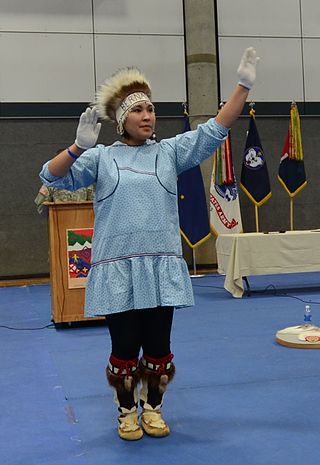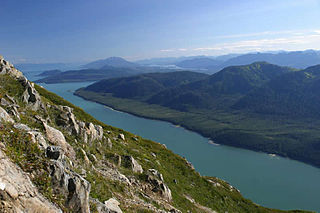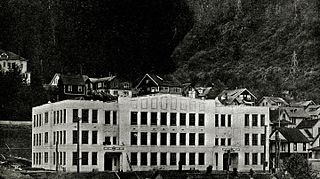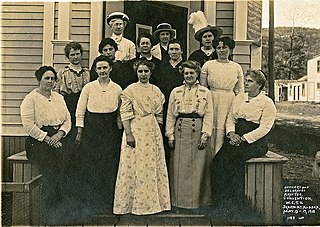
Juneau, officially the City and Borough of Juneau, is the capital of the U.S. state of Alaska, located along the Gastineau Channel and the Alaskan panhandle. Juneau was named the capital of Alaska in 1906, when the government of what was then the District of Alaska was moved from Sitka as dictated by the U.S. Congress in 1900. On July 1, 1970, the City of Juneau merged with the City of Douglas and the surrounding Greater Juneau Borough to form the current consolidated city-borough, which ranks as the second-largest municipality in the United States by area and is larger than either Rhode Island or Delaware.

Sitka is a unified city-borough in the southeast portion of the U.S. state of Alaska. It was under Russian rule from 1799 to 1867. The city is situated on the west side of Baranof Island and the south half of Chichagof Island in the Alexander Archipelago of the Pacific Ocean. As of the 2020 census, Sitka had a population of 8,458, making it the fifth-most populated city in the state.

Kenai is a city in the Kenai Peninsula Borough in the U.S. state of Alaska. By road, it is 158 miles southwest of Anchorage. The population was 7,424 as of the 2020 census, up from 7,100 in 2010, the fifteenth-most populated city in the state.

Klawock is a city in Prince of Wales–Hyder Census Area, in the U.S. state of Alaska, on the west coast of Prince of Wales Island, on Klawock Inlet, across from Klawock Island. The population was 755 at the 2010 census, down from 854 in 2000. It is located 90 kilometres (56 mi) from Ketchikan, 11 kilometres (6.8 mi) from Craig, and 39 kilometres (24 mi) from Hollis.

Petersburg is a census-designated place (CDP) in and essentially the borough seat of Petersburg Borough, Alaska, United States. The population was 3,043 at the 2020 census, up from 2,948 in 2010.

Alaska Natives are the Indigenous peoples of Alaska and include Russian Creoles, Iñupiat, Yupik, Aleut, Eyak, Tlingit, Haida, Tsimshian, and a number of Northern Athabaskan cultures. They are often defined by their language groups. Many Alaska Natives are enrolled in federally recognized Alaska Native tribal entities, who in turn belong to 13 Alaska Native Regional Corporations, who administer land and financial claims.

The Mendenhall Valley [Lingít: Áakʼw Táak] is the drainage area of the Mendenhall River in the U.S. state of Alaska. The valley contains a series of neighborhoods, comprising the largest populated place within the corporate limits of the City and Borough of Juneau, Alaska's capital.

Prince of Wales Island is one of the islands of the Alexander Archipelago in the Alaska Panhandle. It is the fourth-largest island in the United States and the 97th-largest island in the world.

Mendenhall Glacier is a glacier about 13.6 miles (21.9 km) long located in Mendenhall Valley, about 12 miles (19 km) from downtown Juneau in the southeast area of the U.S. state of Alaska. The glacier and surrounding landscape is protected as part of the 5,815 acres (2,353 ha) Mendenhall Glacier Recreation Area, a federally designated unit of the Tongass National Forest.

Gastineau Channel is a channel between the mainland of the U.S. state of Alaska and Douglas Island in the Alexander Archipelago of southeastern Alaska. It separates Juneau on the mainland side from Douglas, on Douglas Island. The first European to sight the channel was Joseph Whidbey whilst serving on the Royal Navy's Vancouver Expedition early in August 1794, first from the south and later from the west. It was probably named for John Gastineau, an English civil engineer and surveyor.

Evergreen Cemetery is a cemetery in Juneau, the capital of the U.S. state of Alaska. It was established in 1887 to replace the older cemetery on Chicken Ridge, near Main Street, when that location was staked as a gold mine. Most of the graves in this older cemetery were moved to the new cemetery between 1889 and 1892 and the rest were moved in about 1915. The grounds were deeded by Evergreen Cemetery Association to the City of Juneau on May 23, 1907.
The Mendenhall River is an Alaskan river north of Juneau in the Mendenhall Valley. The river begins at the Mendenhall Lake, at the base of the Mendenhall Glacier.
The Gravina Island Bridge, commonly referred to as the "Bridge to Nowhere", was a proposed bridge to replace the ferry that currently connects the town of Ketchikan, Alaska, United States, with Gravina Island, an island that contains the Ketchikan International Airport as well as 50 residents. The bridge was projected to cost $398 million. Members of the Alaskan congressional delegation, particularly Representative Don Young and Senator Ted Stevens, were the bridge's biggest advocates in Congress, and helped push for federal funding. The project encountered fierce opposition outside Alaska as a symbol of pork barrel spending and is labeled as one of the more prominent "bridges to nowhere". As a result, Congress removed the federal earmark for the bridge in 2005. Funding for the "Bridge to Nowhere" was continued as of March 2, 2011, in the passing of H.R. 662: Surface Transportation Extension Act of 2011 by the House of Representatives, and finally cancelled in 2015.

The Juneau School District is a school district in Juneau, Alaska. Its office is located in Downtown Juneau.

Elizabeth Peratrovich was an American civil rights activist, Grand President of the Alaska Native Sisterhood, and a Tlingit who worked for equality on behalf of Alaska Natives. In the 1940s, her advocacy was credited as being instrumental in the passing of Alaska's Anti-Discrimination Act of 1945, the first state or territorial anti-discrimination law enacted in the United States.

The Alaska Native Brotherhood (ANB) and its counterpart, the Alaska Native Sisterhood (ANS), are two nonprofit organizations founded to address racism against Alaska Native peoples in Alaska. ANB was formed in 1912 and ANS founded three years later. For the first half of the 20th century, they were the only organizations working for the civil rights of Alaska Natives in the territory and state.

The Capital Transit System is the public transportation agency that serves the City and Borough of Juneau, Alaska. Owned by the municipality, it operates eight bus routes - three of which are labeled as the "Core Service" and run seven days a week with the remaining five running as limited weekday connector. express, or commuter services. Although CTS previously operated routes that offered complete flag stop service along their entire route, routing changes that took place in November 2022 coinciding with the opening of the Mendenhall Valley Transit Center eliminated those routes. In areas where there are no signed bus stops, patrons can still flag down the bus in any location where it is safe for the bus to pull over.
Frank Peratrovich was an American businessman and politician.

Women's suffrage was won fairly easily for non-native women in Alaska in 1913. Prior to becoming a territory, non-native women were able to vote in school board elections. Women's suffrage work took place in the Alaska chapters of the Women's Christian Temperance Union (WCTU). After Alaska was admitted as a territory, the first Territorial Legislature passed a women's suffrage bill in 1913 and was signed into law on March 21. This law only applied to non-native women since Alaska Natives were not considered citizens of the United States. Alaska Natives continued to fight for the right to vote, along with other civil rights throughout the twentieth and twenty-first century.
In the history of discrimination in the United States, the Alaska Equal Rights Act of 1945 was the first state or territorial anti-discrimination law enacted in the United States in the 20th century. The law, signed on February 16, 1945, prevents and criminalizes discrimination against individuals in public areas based on race. The law came about after Alaska Natives fought against segregation and other forms of discrimination in Alaska.

















